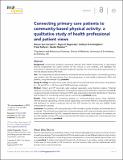Files in this item
Connecting primary care patients to community-based physical activity : a qualitative study of health professional and patient views
Item metadata
| dc.contributor.author | Carstairs, Sharon A | |
| dc.contributor.author | Rogowsky, Rayna Hilary | |
| dc.contributor.author | Cunningham, Kathryn Burns | |
| dc.contributor.author | Sullivan, Frank | |
| dc.contributor.author | Ozakinci, Gozde | |
| dc.date.accessioned | 2020-07-23T11:30:03Z | |
| dc.date.available | 2020-07-23T11:30:03Z | |
| dc.date.issued | 2020-07-21 | |
| dc.identifier | 261276250 | |
| dc.identifier | fa52fe16-b7b6-4089-83e9-09e91876ce35 | |
| dc.identifier | 32694135 | |
| dc.identifier | 85091523558 | |
| dc.identifier.citation | Carstairs , S A , Rogowsky , R H , Cunningham , K B , Sullivan , F & Ozakinci , G 2020 , ' Connecting primary care patients to community-based physical activity : a qualitative study of health professional and patient views ' , BJGP Open , vol. Latest Articles . https://doi.org/10.3399/bjgpopen20X101100 | en |
| dc.identifier.issn | 2398-3795 | |
| dc.identifier.other | ORCID: /0000-0001-5869-3274/work/77893678 | |
| dc.identifier.other | ORCID: /0000-0001-6593-5972/work/77893820 | |
| dc.identifier.other | ORCID: /0000-0002-3300-7220/work/77893854 | |
| dc.identifier.other | ORCID: /0000-0002-6623-4964/work/77893800 | |
| dc.identifier.uri | https://hdl.handle.net/10023/20317 | |
| dc.description | Funding: NHS Fife Endowment Fund Grant which was awarded as part of a larger project (FIF142). | en |
| dc.description.abstract | Background Inconclusive evidence supporting referrals from health professionals to gym-based exercise programmes has raised concern for the roll-out of such schemes, and highlights the importance of developing links between healthcare settings and community-based opportunities to improve physical activity (PA) levels. Aim This study aimed to identify methods, and explore barriers and facilitators, of connecting primary care patients with PA opportunities from the perspectives of both health professionals (HPs) and patients, using the example of jogs cotland. Design & setting An exploratory study utilising semi-structured interviews with primary care patients (n = 14) and HPs (n = 14) from one UK NHS board was conducted. Method Patient and HP transcripts were analysed separately using thematic analysis. Potential methods of connection were identified. The Capability, Opportunity, Motivation, behavioural (COM-B) model and theoretical domains framework (TDF) were employed to facilitate identification of barriers and facilitators for connecting primary care to community jogscotland groups. Results Three methods of connecting patients to community-based groups were identified: informal passive signposting, informal active signposting, and formal referral or prescribing. Barriers and facilitators for patient connection fell into five TDF domains for HPs and two COM-B model components for patients. Conclusion For patients, HPs raising the topic of PA can help to justify, facilitate, and motivate action to change. The workload associated with connecting patients with community-based opportunities is central to implementation by HPs. Integrative resource solutions and social support for patients can provide a greater variety of PA options and the vital information and support for connecting with local opportunities, such as jogscotland. | |
| dc.format.extent | 13 | |
| dc.format.extent | 1049289 | |
| dc.language.iso | eng | |
| dc.relation.ispartof | BJGP Open | en |
| dc.subject | Physical activity | en |
| dc.subject | Health promotion | en |
| dc.subject | Social prescribing | en |
| dc.subject | Primary health care | en |
| dc.subject | Consultation | en |
| dc.subject | Motivation | en |
| dc.subject | RA0421 Public health. Hygiene. Preventive Medicine | en |
| dc.subject | DAS | en |
| dc.subject | SDG 3 - Good Health and Well-being | en |
| dc.subject.lcc | RA0421 | en |
| dc.title | Connecting primary care patients to community-based physical activity : a qualitative study of health professional and patient views | en |
| dc.type | Journal article | en |
| dc.contributor.sponsor | INDIVIOR | en |
| dc.contributor.institution | University of St Andrews. School of Medicine | en |
| dc.contributor.institution | University of St Andrews. Population and Behavioural Science Division | en |
| dc.contributor.institution | University of St Andrews. Sir James Mackenzie Institute for Early Diagnosis | en |
| dc.contributor.institution | University of St Andrews. Health Psychology | en |
| dc.contributor.institution | University of St Andrews. St Andrews Sustainability Institute | en |
| dc.identifier.doi | 10.3399/bjgpopen20X101100 | |
| dc.description.status | Peer reviewed | en |
| dc.date.embargoedUntil | 2020-07-21 | |
| dc.identifier.url | https://dx.doi.org/10.21203/rs.3.rs-15539/v1 | en |
| dc.identifier.grantnumber | N/A | en |
This item appears in the following Collection(s)
Items in the St Andrews Research Repository are protected by copyright, with all rights reserved, unless otherwise indicated.

